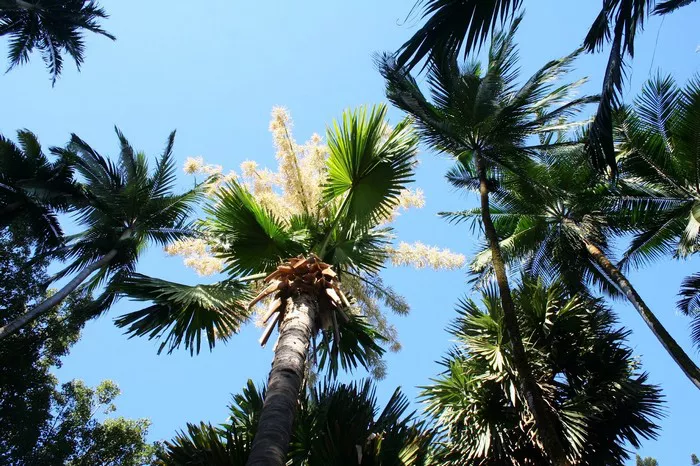A rare botanical spectacle has captivated visitors to the Royal Botanic Gardens in Port of Spain, Trinidad. Currently in full bloom is the Talipot Palm (Corypha umbraculifera), renowned for its singular flowering event in its lifetime. Situated along the southern perimeter of the gardens, this majestic palm is drawing crowds eager to witness its remarkable display.
Originating from eastern and southern India as well as Sri Lanka, the Talipot Palm, also known as the Century Palm, is famed for bearing the largest inflorescence globally. Despite the common misconception that it blooms only once every century, the truth is that it flowers upon reaching maturity, typically between 25 to 80 years of age. Following flowering, a process that takes approximately a year, the palm produces numerous small, circular yellow-green fruits, each containing a single seed. However, due to its monocarpic nature, the palm withers and dies after this extraordinary bloom.
Dr. Linton Arneaud, a lecturer in plant science at The University of the West Indies (UWI) and vice-president of the Trinidad and Tobago Field Naturalists’ Club, shed light on the etymology of the palm’s species name. According to him, “Corypha means top. Umbraculifera means umbrella […] so it’s speculated that the name is referring to the flower to the top, and the fronds are in the shape of an umbrella.”
For locals accustomed to the flamboyance of events like the Carnival, the Talipot Palm’s floral arrangement might evoke comparisons to the clustered feathers adorning costume headpieces.
This remarkable palm is just one of the 72 exotic palm species featured in a publication by the Field Naturalists’ Club. In regions across Asia, the tree serves various purposes, including as a source of timber, thatch, and even buttons crafted from its seeds. Historical accounts suggest that its leaves, known as “olas,” were once utilized as palm leaf manuscripts in certain Southeast Asian cultures, with the famous Sanskrit epic “Ramayana” purportedly inscribed on them.
While the Talipot Palm is not unique to Trinidad, its current bloom at the Botanic Gardens has garnered significant attention, with similar specimens found in other Caribbean islands, including Jamaica’s Hope Gardens.
Renowned environmentalist Ian Lambie expressed his delight over the palm’s flowering on social media, advocating for the collection and distribution of its seeds to ensure future generations of flowering Talipot Palms.
The public fascination with this botanical wonder has led to a surge in visitors to the Botanic Gardens, with many seizing the opportunity to witness the spectacle firsthand and capture memorable photographs.
For those unable to experience it in person, the allure of this rare botanical event continues to be shared through various media channels.


